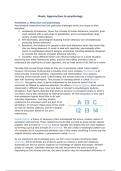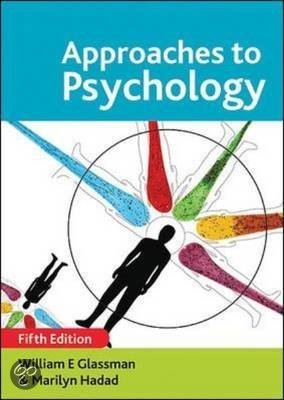Book: Approaches to psychology
Hoofdstuk 1: Behaviour and psychology
Psychological researchers face four particular challenges which are unique to their
discipline:
1. complexity of behaviour; Given the richness of human behaviour, psycholo- gists
must contend with a vast range of possibilities, and a correspondingly large
variety of data (observations).
2. Self-awareness; psychologists studying human behaviour are simultaneously
producing human behaviour.
3. Reactivity; the tendency for people to alter their behaviour when they know that
they are being observed. In order to deal with reactivity, psychologists often
resort to complicated research designs, sometimes including deliberate deception
to increase the chances of people behaving naturally.
4. Causality; many different factors can influence behaviour in a given situation.
Examining how these frameworks arose, and how they differ, provides a way to
understand the significance of each approach, and to make sense of the field as a whole.
The idea that we see things simply as they are is sometimes called ‘naive realism’;
however, the process of perceiving is actually much more complex. Perception is an
active process involving selection, organisation and interpretation, not a passive
mirroring of the external world. Unfortunately, the human brain has a limited capacity to
deal with incoming information. This process of choosing stimuli is called selective
attention. Perception, then, is partly determined by the external stimuli that we
encounter, as filtered by selective attention. So-called ambiguous figures, which can be
interpreted in different ways, have long been of interest to psychologists studying
perception. Such figures illustrate that what we perceive is not based simply on what is
‘out there’, but is also influenced by internal processes. On first encounter, it may seem
that ambiguous figures have little to do with
everyday experience – but they actually
underscore the processes which are part of all
perception. In trying to make sense of the world,
we look for familiar patterns, and we interpret
what we encounter based on our prior
experiences.
Gestalt theory: a theory of behaviour which emphasised the active, creative nature of
perception and learning. These researchers found that we tend to group similar objects
together (the principle of similarity) and we typically see objects that are close together
as forming a group (the principle of proximity). We also create a meaningful pattern out
of a complex set of unconnected elements even if this means modifying in some way the
original stimulus information, a phenomenon called closure.
As our experience and knowledge grow, we form more complex structures called
schemata. Some schemata are scripts to guide our actions in particular situations.
Schemata can also be used to organise our knowledge of objects and people. Whether
simple or complex, schemata influence the way we perceive the world around us.
Depending on the schema one has, the same situation may be interpreted differently: A
,Brazilian settler may see a rainforest as something to be cleared in order to create a
farm; an environmental activist may see the same forest as a priceless ecosystem.
There is no right or wrong schemata, they just differ per person. But sometimes
schemata lead us to distorted perceptions of the world, and some of these distortions
may be serious, especially when our schemata involve faulty or inaccurate assumptions.
For example, when we form a schema about a group of people, we may be fashioning a
stereotype. An oversimplified and often inaccurate perception of an individual based on
generalising from schemata related to the individual’s group membership. Confirmation
bias: a form of cognitive error based on the tendency to seek out information which
supports one’s belief, and to ignore contradictory information.
The impact of culture is a broad issue, and no complete analysis can be given here. As
should be evident, people in all cultures have striven to understand human behaviour,
and have developed different types of frameworks and explanations. In that sense, the
five approaches on which we will focus represent frameworks that have been particularly
significant, not the only possible ways of seeking to understand behaviour. In the end, it
is important to remember that psychology is a science, but all science is a human
endeavour. Understanding the richness of that endeavour requires acknowledging the
people who contribute to its development, and the social contexts in which they live. For
the moment, let us consider the general context in which psychology as a discipline
emerged.
Functionalism: an approach to the study of behaviour pioneered by William James, which
emphasises the analysis of the processes by which the mind works.
Structuralism: an approach to psychology pioneered by Wundt which attempted to
analyse the contents of the mind, using the introspectionist method.
Empirical: based on making observations, as in an empirical theory. This means that
observations can be verified by different observers. In this sense, psychology is a public
endeavour, which cannot depend on secret knowledge or mystic inspiration.
Understanding and explanation require the formulation of general principles; at the
highest level, a structured set of principles is called a theory. A theory provides a
coherent structure for relating various observations, and often permits prediction of
future observations.
- observations and theories are complementary to each other: observations
suggest a theory, a theory is tested by observations, observations suggest
modifications of the theory, and so on.
Induction: a process of reasoning based on forming general principles from specific
observations.
Deduction: the process of drawing specific conclusions from a set of general principles.
Hypothesis: a statement describing proposed relationship between variables; a specific
outcome or prediction derived from a theory which can be evaluated by making further
observations.
Introspectionism: a method of gathering data in which the individual attempts to analyse
the content of their conscious mind; associated with the structuralist approach. To avoid
the problems of introspection, psychology, like other forms of science, has come to
emphasise public techniques of observation, which make it possible for observers to
agree on what has occurred.
Operational definition: a term meaning is defined by the processes or observable events
used to measure it.
,Since research requires making observations, the most basic question is what sort of
measure of behaviour to use. Generally speaking, observation can be based on two
different ways of measuring behaviour:
- Self-report: a method of gathering data which involves asking an individual to
describe their behaviour or mental state in some way, such as an interview,
survey or psychological inventory.
- Think-aloud protocol: a transcript of the comments made when an individual is
asked to describe their thoughts and behaviour while working on a task such as
problem solving.
The alternative to self-report procedures is for researchers to use direct observation of
the behaviour of interest; in this case, the researcher observes behaviour in some way
that does not depend on what the individual says. Direct observation by an independent
person tends to be more neutral or objective than self-report, and is more easily verified
by having multiple observers. Overall, direct observation is used most frequently in
experiments, although observational methods take many forms, as we will see.
Research setting: context in which research is conducted, either a laboratory setting
(which involves having participants come to a special location), or a field setting (which
requires going to where the people are whom the researcher wishes to study).
research method: a procedure for examining a problem and gathering observations; in
broad terms, research methods are either experimental or non- experimental.
non-experimental methods: research methods which do not involve direct control of any
factor, in contrast to experiments; sometimes called descriptive/ correlational designs.
Experience sampling methods (ESM): methods of studying thoughts and feelings in real
time using communications technology.
variable any measured characteristic which shows variation across cases or conditions.
correlation a pattern or relationship observed between two variables.
correlation coefficient a descriptive statistic measuring the degree of relationship
between two variables. For positive correlations, it is a number which varies between 0.0
and +1.0, and for negative correlations between 0.0 and –1.0; in both cases, the closer
the value is to 1, the stronger the relationship between the two variables.
illusory correlation a cognitive error in which an individual perceives a relationship
between variables where none actually exists.
diffusion of responsibility a lessening of an individual’s feeling of responsibility in a
situation which involves other people.
Social influence is a general term for the
various ways in which an individual’s
behaviour is affected by others, such as
conformity pressures and social
expectations.
Quasi-experiment a research design in
which participants are assigned to
groups based on variables which cannot
be manipulated by the researcher (such
as age, height, sex).
, Hoofdstuk 2: The biological approach
The biological approach is oriented towards understanding the physiological and genetic
basis of our behaviour. Within psychology, it is the only approach which tries to explain
behaviour in terms of the workings of the physical system.
Phantom limb: a mysterious phenomenon in which individuals who have lost a limb will
often continue to experience sensations which seem to come from the missing limb.
Mind is used to refer to our experience of awareness, or consciousness; it has no direct
reference to physical form. The body, of course, refers to our physical being, and
includes what many feel is the basis of mind – the brain.
Dualism: the view first attributed to Descartes, that mind and body are distinct
(verschillend); Descartes believed the two could interact via the pineal gland in the
brain. Today, researchers in the biological approach reject dualism in favour of monism,
the belief that mind and body are a single entity (in most respects this is equivalent to
materialism, which assumes all behaviour has a physical basis).
localization of function the assumption that specific functions are associated with specific
areas of the brain. (Lamarck → Darwin (survival of the fittest, natural selection.))
Psychoactive drugs (mind-affecting) is a concern in both psychology and medicine, and
has given rise to a hybrid field called psychopharmacology.
Obviously, it is difficult to assess these effects (the influence of drugs on behaviour) in
animals. This leads to the most basic problems in studying drugs: how to describe and
categorise the effects. By their nature, drugs operate on the physical system, yet the
behavioural changes are primarily mental (perception, memory, etc.). This leads back to
the problem of linking mind and body. Consider some of the possible difficulties:
1. Some drugs will affect only certain clinical groups, and not other types of patients
or healthy individuals.
2. Some drugs affect sensory capacities in ways that are not directly expressed in
behaviour. Consequently, even with verbal reports from subjects, it can be
difficult to determine what is happening.
3. It is convenient to categorise drugs, but the categories may not always fit well
with the subtleties of drug effects.
Essentially, all psychoactive drugs operate by affecting communication between neurons.
As was described earlier, communication across the synapse is dependent on
neurotransmitters. These chemical messengers are released by the terminals at the end
of the axon, and flow across the synaptic gap to the receptors on the next neuron.
Endorphins; a neuropeptide which plays a significant role in pain and mood states.
- Neuropeptide: chemicals which function as both hormones and neurotransmitters.
Psychoactive drugs are commonly divided into various categories, according to the
general nature of their effects on behaviour, one category ofert overlooked in daily
experience is the Stimulants: act on both the CNS (central nervous system) and the
autonomic nervous system (a portion of the peripheral nervous system that controls
such functions as heart-rate and breathing), typically by increasing levels of dopamine;
these drugs tend to decrease fatigue, increase physical activity and alertness, diminish
hunger, and produce a temporary elevation of mood.






